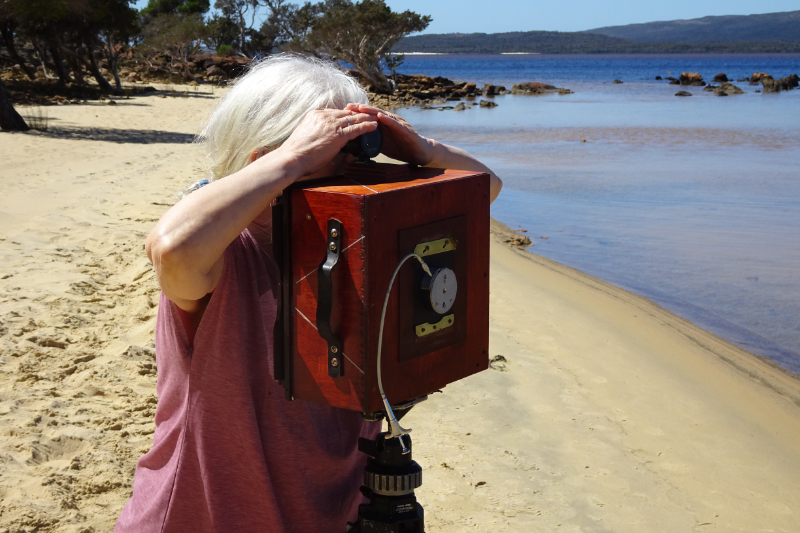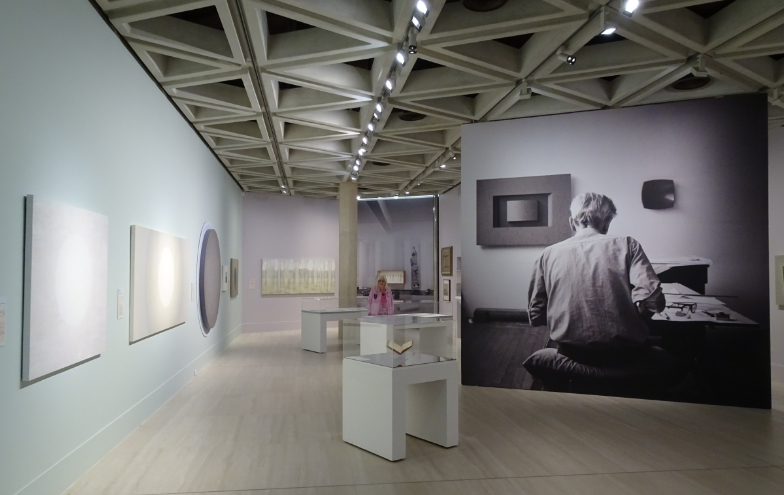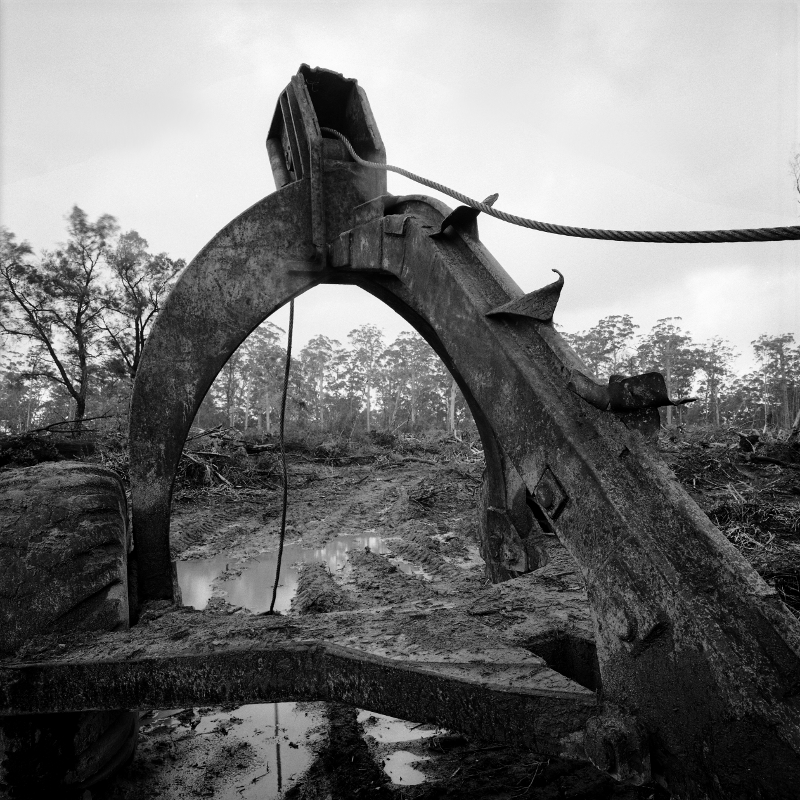It Woke The Town Up (text)
May 11th, 2024 • Exhibitions
ENVIRONMENTAL DOCUMENTATION
It Woke The Town Up (text)
PREFACE:
This is the text of a brief talk that was planned for the second iteration of the exhibition “It Woke the Town Up” about the July 1976 Bombing of the Bunbury Woodchip Terminal.
The first showing of “It Woke the Town Up” was in Bunbury Museum from Wednesday 17 April to Saturday 25 May 2024. The show was instigated and curated by Dr Amanda Gardiner. My input were the four images shown here.
Due to practical consideration I will be unable to deliver it in person. It was intended to have a changing background of projected images, but . . .
Gardner Forest 1998
Hello,
I shall open this brief address with my reasons for documenting the karri forest, then observations on photo-documentation followed by images from a single day and finally comment about means, all in fewer than nine minutes.
Boorara Forest late January 2000
OED’s second definition of documentary is “providing a factual record or report”.
Like Janus, it faces two ways. It looks back to bear witness to events and forwards to produce material to effect change or, when this fails, for later accusation.
Boorara Forest Early May 2000
I moved to Quinninup in nineteen ninety four, intending much of my personal photography to be a celebration of forest. My first walks beyond the lying line of roadside trees showed the truth, there was little that was quiet or beautiful behind the line. It was coupe after coupe after coupe of greed driven desolation. I knew within my first few days in the story I would engage with.
But subject is one thing, treatment is another. A documentary photograph is an abstract from an event, a biased shadow in Plato’s Cave. It is not the event itself.
This short poem by Kenneth White, about the painter Sesshu Toyo, has influenced my photographic approach since nineteen seventy one:
After years in China
emptiness achieved
he painted
with the fewest of strokes
the hardness of rocks
the twistedness of roots.
For a photographer this poem addresses several issues. One of these to use economy of means to enable the subject to be as clearly and accurately depicted as possible.
I believe the sole allegiance of a documentary worker must be to the subject, achieved through engagement with that subject.
Also, to enable the subject to be shown clearly the photographer, or writer or video worker, must be fiercely independent of editorial constraints and from the narrowing influence of a hierarchical peak body.
Regarding social peak bodies, a young drunk trainee photojournalist from Newport College of Photojournalism said to Rae at a party in Bristol, about working for social organisations, here paraphrased without the copious swearing:
“As a student I work for them as a volunteer, and those [two word pause] try to dictate what I photograph, they can’t do that. They will get what I engage with.”
It is also important, through strict control of copyright and publication, to safeguard images from being used in ways contrary to their origin or meaning.
Disregard of original context has been a problem for documentary photographers from the very beginning and examples are legion. One way to mitigate misuse is for photographers to write, where possible, their own captions, articles and scripts.
I quote:
“The contemplation of things as they are, without substitution or imposture, without error or confusion is in itself a nobler thing than a whole harvest of invention.”
Attributed to Francis Bacon
To enable their understanding of the subject a photographer should undertake their own independent research from trustworthy sources.
Research because it is important that we be accurate in our reporting. Extractive industries can be wilfully mendacious and obfuscatory and are rewarded for it with government grants and contracts. We, however, are hounded to Hades for any small error of fact.
But, big but, no matter the effort we put into making images faithful to the subject we are still only offering shadows.
Kenneth White’s poem also implies aesthetic engagement.
Aesthetic engagement, meaning design and aesthetics, is not a rules based thing, although there are certain visual conventions which make an image attractive and quickly readable, a visual equivalent to grammar and syntax in writing, but while useful, they are merely visual conventions.
Aesthetic experiment is also where we have room to play and and push visual boundaries and explore ways to tell a story.
SUBJECTIVE BIAS:
Subjective bias - at the opening I referred to the fact a photograph is an abstract from an event, a personalised shadow from Plato’s cave. “A photograph never lies” and “A picture is worth a thousand words” are glib statements that attempt to sidestep the unavoidable bias of the photographer or writer.
Subjective bias is shown in the choices of subject, viewpoint, timing, visual treatment and politics. This bias can not be avoided. Bias is showing only one side of a story, but not quite the same thing as falsehood.
I have never tried to conceal my biases. I don’t need to as the cacophony of right wing media is deafening and I am one small voice in favour of life.
In addition to the photographer’s bias there is the added bias of the viewer to consider.
These biases can be understood through thoughtful viewing and informed critical debate, which means looking at imaghes and understanding how they function.
No one wants the tedium of unbiased photo-journalism, but we must still strive for accuracy within the limitations of what we record.
PART II: PENNY’S DRAGON.
Change of direction, my work.
Another aspect of the opening poem that struck me was that the subject matter referred to is depiction of the natural environment, which is where my work started in nineteen seventy.
I still find it impossible to do good work if I am not personally engaged with the subject.
My four prints here are large, slow and deliberate pictures made with large, slow and deliberate cameras.
The two images of karri forest, the healthy one and the snig track, are from the same coupe in Boorara Forest and span a period of just over three months.
In contrast, my other work from that period was made with old Nikons. The pictures I am projecting today are from “Penny’s Dragon” on the tenth of December nineteen ninety eight, starring Penny Scull in a road dragon in Wattle State Forest.
Looking at these images after twenty five years reminds me of the callous disregard for human safety shown by the Department of Conservation and Land Management, the Timber Industry and the WA Police.
The most dignified moment of this event was Penny’s smile of victory when she was finally arrested after a day bravely frustrating the logging industry. Bravely because she could have unlocked from that dragon at any time, but she stayed locked-on to the end.
PART III MEANS:
My forest defence photographs were made at the juncture between film and digital photography.
I chose to continue with black and white film because I had the equipment, a superb darkroom, finely honed skills, a passion for the medium, but mainly because I had no money for a digital camera or a computer.
Two kinds of black and white prints were made, fine fibre based prints for my archive and cheap laminated prints for public displays to convince the Perth public of the long term importance of defending the forest and for changing the government. But industry owns both parties, so no good came of that!
The first public showing of fine prints was in my second twenty four year survey show at Bunbury Gallery in twenty seventeen. The four prints here are from this survey show, I have a plan chest full of others.
In April two thousand and three my forest documentation ceased when I slammed into a cliff of depression. I no longer go into the forest.
Now, twenty five years later, digital photography combined with the Wise and Wonderful Web is the most obvious medium for environmental documentation. But it is not the only one.
With the second generation of digital photography comes the danger of image manipulation amplified by the computing power of AI. AI and social media mark the public ceasing to believe in the myth of photographic veracity.
I am now learning the craft of digital video production as a vehicle to protect the Unicup Wetlands and local peat swamps. Video, as video is the lingua franca of our time.
My approach to video is based on having a clear script to guide the process. I decided on this traditional path as the medium is changing quickly and the script provides a narrative anchor. With the rapid improvements of mobile ‘phone cameras and the new, agile, palm sized drones the image recording can change quickly. The script keeps it on track.
Finally, I try to be almost invisible at protest events. I regard invisibility as a documentary photographer’s super power.
← Return to Blog





 RSS Feed
RSS Feed